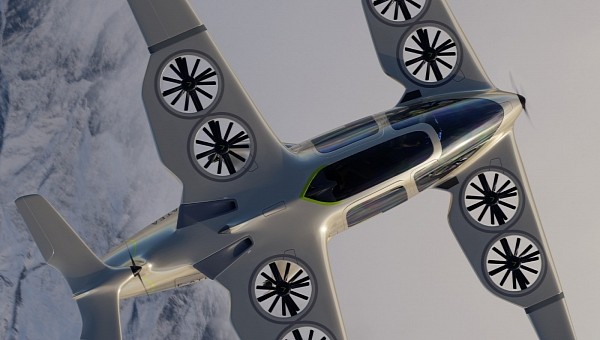France isn’t staying behind when it comes to AAM (Advanced Air Mobility) development. In addition to several infrastructure projects, it’s also gearing up for the launch of a domestically-made VTOL (vertical take-off and landing) with a twist.
At the beginning of 2021, we got a glimpse of the French eVTOL named Atea, for the first time. As it often happens in the AAM world, the company that introduced Atea was founded by experts in the industry, who had previously worked for big names in the field (in this case, Airbus).
Since then, Ascendance Flight Technologies has expanded a great deal and is now getting ready to kick off the type certification process for Atea. A recent boost of €21 million ($22.6 million) will enable it to start a flight test campaign with the full-scale prototype, on the path to the EASA (European Union Aviation Safety Agency) certification.
Right from the start, Ascendance stood out among eVTOL designers due to the hybrid propulsion approach.
Today, it still considers this to be the “realistic” solution for sustainable aviation. This way, Atea can be used in multiple areas, from passenger transport and medical emergencies to logistics and surveillance, compared to fully-electric aircraft with a limited range.
The French eVTOL promises a 400-km (nearly 250 miles) range while flying at 200 kph (124 mph). It’s mainly intended as an alternative to conventional helicopters - compared to these, it produces 80% fewer carbon emissions and operates much more quietly.
The aircraft’s main strength is called Sterna, the hybrid propulsion technology developed by the same builder. Sterna combines modular architecture and the latest battery solutions for aeronautical applications, with an advanced system for onboard energy management.
Sterna can basically use multiple energy sources at the same time. Its thermal combustion module can be powered by either SAF (sustainable aviation fuel) or hydrogen, both clean alternatives to conventional fuel. Thanks to Sterna, Atea can provide the benefits of hybrid propulsion (mainly a longer range) while still being able to drastically cut emissions, by using alternatives to conventional fuel.
Even better, the Sterna propulsion system is modular, which makes it compatible with existing aircraft as well. This puts the French startup ahead of its competitors. Many of them are only focusing on aircraft design while working with multiple partners for the motor and flight controls. Ascendance designed an aircraft and a propulsion solution, too.
So far, Ascendance claims to have secured 245 LOI (letters of intent for the Atea eVTOL, plus separate partnerships for integrating Sterna onto current aircraft. With this fresh funding, it can now focus on test flights at its new facilities at the Muret L’Herm aerodrome, near Toulouse. Atea is expected to enter service by 2026.
Since then, Ascendance Flight Technologies has expanded a great deal and is now getting ready to kick off the type certification process for Atea. A recent boost of €21 million ($22.6 million) will enable it to start a flight test campaign with the full-scale prototype, on the path to the EASA (European Union Aviation Safety Agency) certification.
Right from the start, Ascendance stood out among eVTOL designers due to the hybrid propulsion approach.
Today, it still considers this to be the “realistic” solution for sustainable aviation. This way, Atea can be used in multiple areas, from passenger transport and medical emergencies to logistics and surveillance, compared to fully-electric aircraft with a limited range.
The French eVTOL promises a 400-km (nearly 250 miles) range while flying at 200 kph (124 mph). It’s mainly intended as an alternative to conventional helicopters - compared to these, it produces 80% fewer carbon emissions and operates much more quietly.
The aircraft’s main strength is called Sterna, the hybrid propulsion technology developed by the same builder. Sterna combines modular architecture and the latest battery solutions for aeronautical applications, with an advanced system for onboard energy management.
Sterna can basically use multiple energy sources at the same time. Its thermal combustion module can be powered by either SAF (sustainable aviation fuel) or hydrogen, both clean alternatives to conventional fuel. Thanks to Sterna, Atea can provide the benefits of hybrid propulsion (mainly a longer range) while still being able to drastically cut emissions, by using alternatives to conventional fuel.
Even better, the Sterna propulsion system is modular, which makes it compatible with existing aircraft as well. This puts the French startup ahead of its competitors. Many of them are only focusing on aircraft design while working with multiple partners for the motor and flight controls. Ascendance designed an aircraft and a propulsion solution, too.
So far, Ascendance claims to have secured 245 LOI (letters of intent for the Atea eVTOL, plus separate partnerships for integrating Sterna onto current aircraft. With this fresh funding, it can now focus on test flights at its new facilities at the Muret L’Herm aerodrome, near Toulouse. Atea is expected to enter service by 2026.







